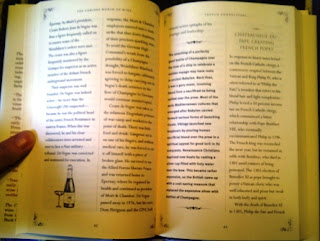 |
| Luckily these bottles were empty before the SEC Championship. |
Typically picking up Holiday gifts at the grocery store is considered, if you'll forgive the pun, in poor taste. What could grocery store shelves hold of any value beyond the tan and gold boxes of candy with maybe two edible pieces in them? Okay, I'll always take a bag of Dove Dark Promises (no Hershey's for this half-Belgian, please), but I'm talking about wine. It seems that there are some hidden gems for reasonable prices out there.
Our first foray this year into reasonable gift wines came courtesy of some wine samples from Deutsch Family Wine & Spirits. Yes, FCC, these were samples, but as you'll see, their free-ness didn't influence our opinions. We tasted them at a dinner gathering with a couple of friends, one of whom has been in the restaurant/hospitality industry for several years.
The first wine wins the "most likely to be damned by its label before it's given a fair chance" award. It was pitched in the original email as the perfect gift for "that bubbly person who keeps you smiling! Maybe your girlfriend who brings a smile on your face, or your best friend who is the one you’re sharing laughs with and celebrating life with." Yes, it's bubbly and pink. It also has a kangaroo on the label. We found hints of strawberry on the nose, and the wine itself is off-dry with some strawberry stem, and lots of tropical fruit mid-palate & on the finish. Our friend noted that, if no one ever saw the Yellow Tail label, it could be a good choice for a restaurant house bubbly. I liked it and would give it a good to very good rating. It would also be fun to surprise our wine snob friends at their annual New Year's party. For a suggested retail price (SRP) of $10, it was deemed "Totally worth it."
Region: Southeastern Australia
Varietals: Semillon, Traminer, Shiraz, Frontignac
 |
| Couldn't resist the Christmas tree shot. |
Finally, the 2011 Ruta 22 Malbec (Patagonia, Argentina), designated the "the gift for the adventurous, travel-lover on your list" rounded off the evening. The nose was a little gamey, which is not unpleasant for a wine that begs to be paired with meat. It was juicy but not jammy with berry and dark fruit. Some found the peppery finish to be a bit much. Forget the travel-lover, bring this as a hostess gift to a meat lover who's serving a nice juicy roast. I feel the SRP of $13 is about right.
Our other "Go-to Wine" tasting came courtesy of JavaMonkey in Decatur, Georgia, and all of these should be available at the Dekalb Farmers' Market and are all under $15. Since they're fairly reasonable, consider getting a magnum to wield against the pre-Christmas shoppers. Yes, FCC, we paid for this tasting. Fellow blogger Dan Browning and I decided to play off the go-to theme with our comments.
The wines:
2011 Protocolo Blanco (Vino de la Tierra de Castilla, Spain): 70% Arien, 30% Macabejo
Go to the beach with this crisp, mineral wine with a gardenia nose and lemony finish.
Rating: Good to Very Good
2010 La Craie (Vouvray, Loire Valley, France): 100% Chenin Blanc
Go to the tropics with a nice, light nose and plenty of pineapple and tropical fruit.
Rating: Very Good
 |
| Love the label! |
2011 Monte Oton (Borja, Spain): 100% Garnacha
Git along little doggie. This wine smells like meat and butter. It starts leathery, but as it opens, more fruit comes out. I'd pair this with a Tanja Michaels Texas romance novel and a steak. Yeah, I might have made the comment that it's like licking a cowboy. No, I don't really know what that's like. Moving right along…
Rating: Good
2010 Santa Ema Merlot (Peumo, Cachapoal Valley, Chile): 100% Merlot
Go to the housetop. Yep, it's got some clove and a little cedar on the palate. It's medium-bodied, but still has a lot of nice, dark fruit. Santa might prefer this one to milk.
Rating: Good
2010 Castaño Monastrell (Yecla, Spain): 100% Monastrell
Going… (No, I'm not sure how that one tied in) A little funky and bitter at first, which was disappointing after the nice dark fruit nose.
Rating: Okay
2011 Château Pesquié Terrasses Red (Ventoux, France): 70% Grenache, 30% Syrah
Vas-tu au Ventoux! Hubby and I discovered wines from this sub-region of the Rhone Valley on a trip to Belgium a few years ago, and we snap them up when we do. This one had a funky French Syrah nose, and was dark and smooth with just a hint of frizzante (mild fizziness). This would be a great one to take to a party.
Rating: Very Good
Whatever you happen to be drinking this holiday season, I hope you enjoy it and stay safe. Happy Holidays from me, Hubby, and the blog cats!




























